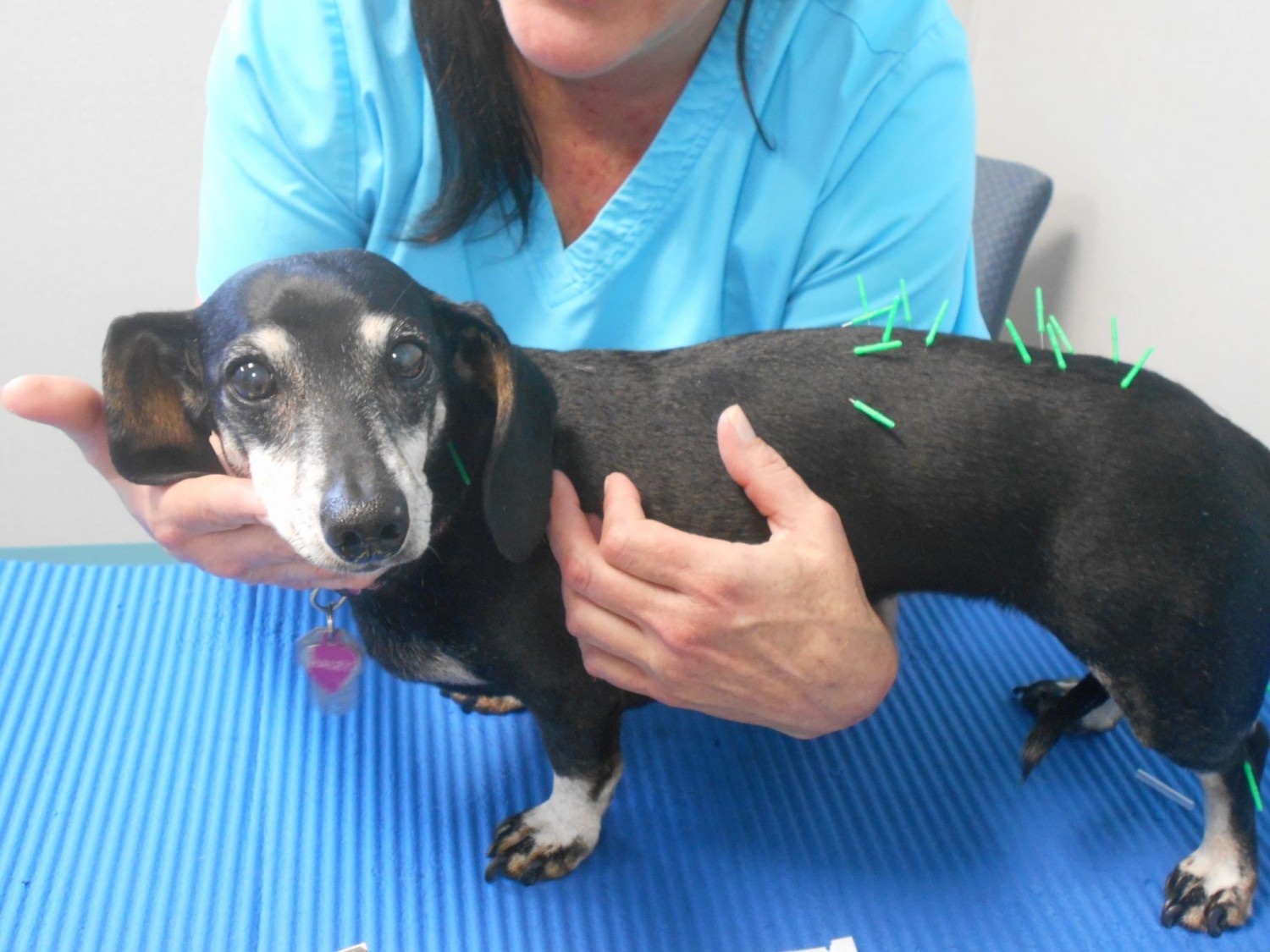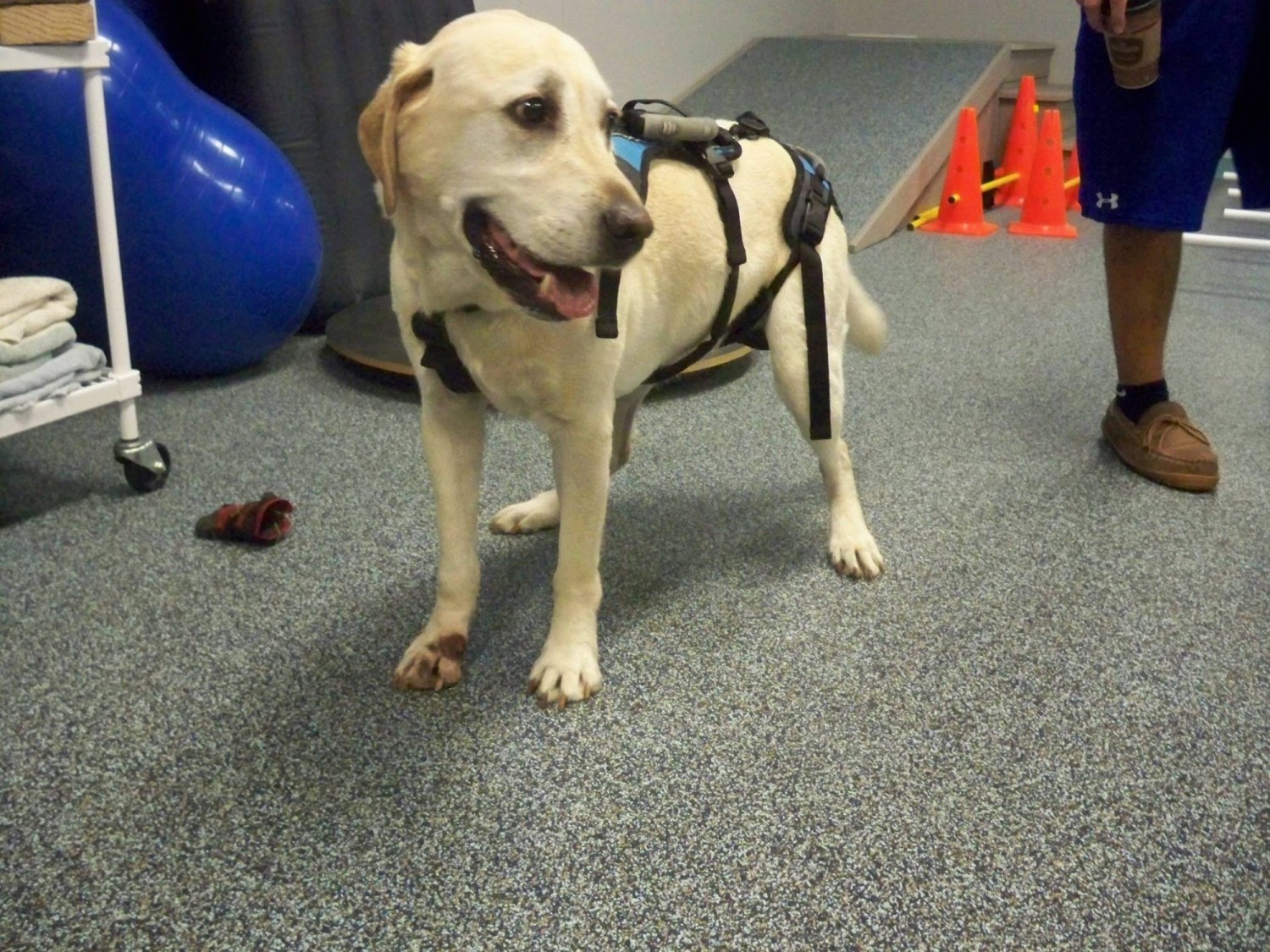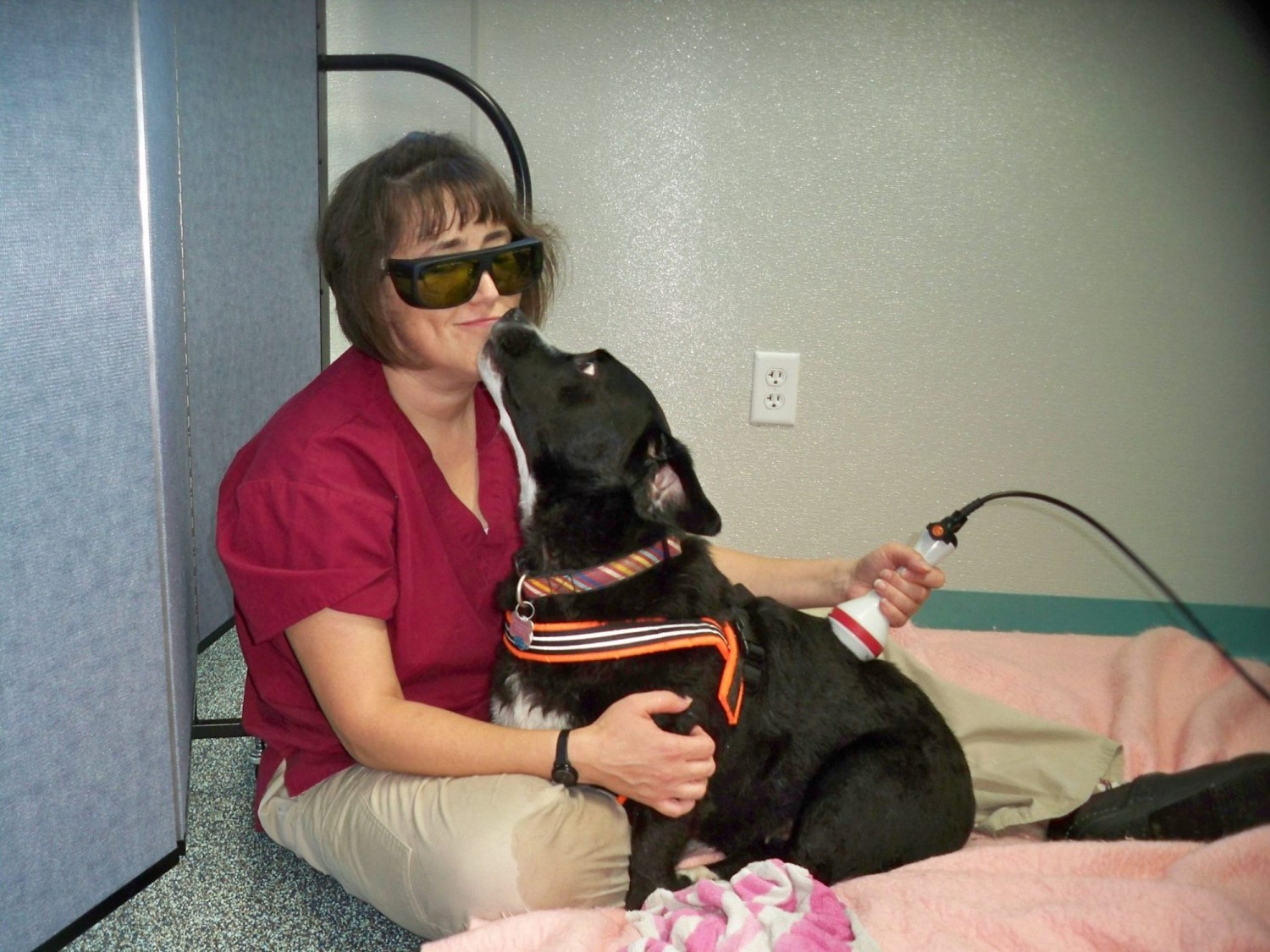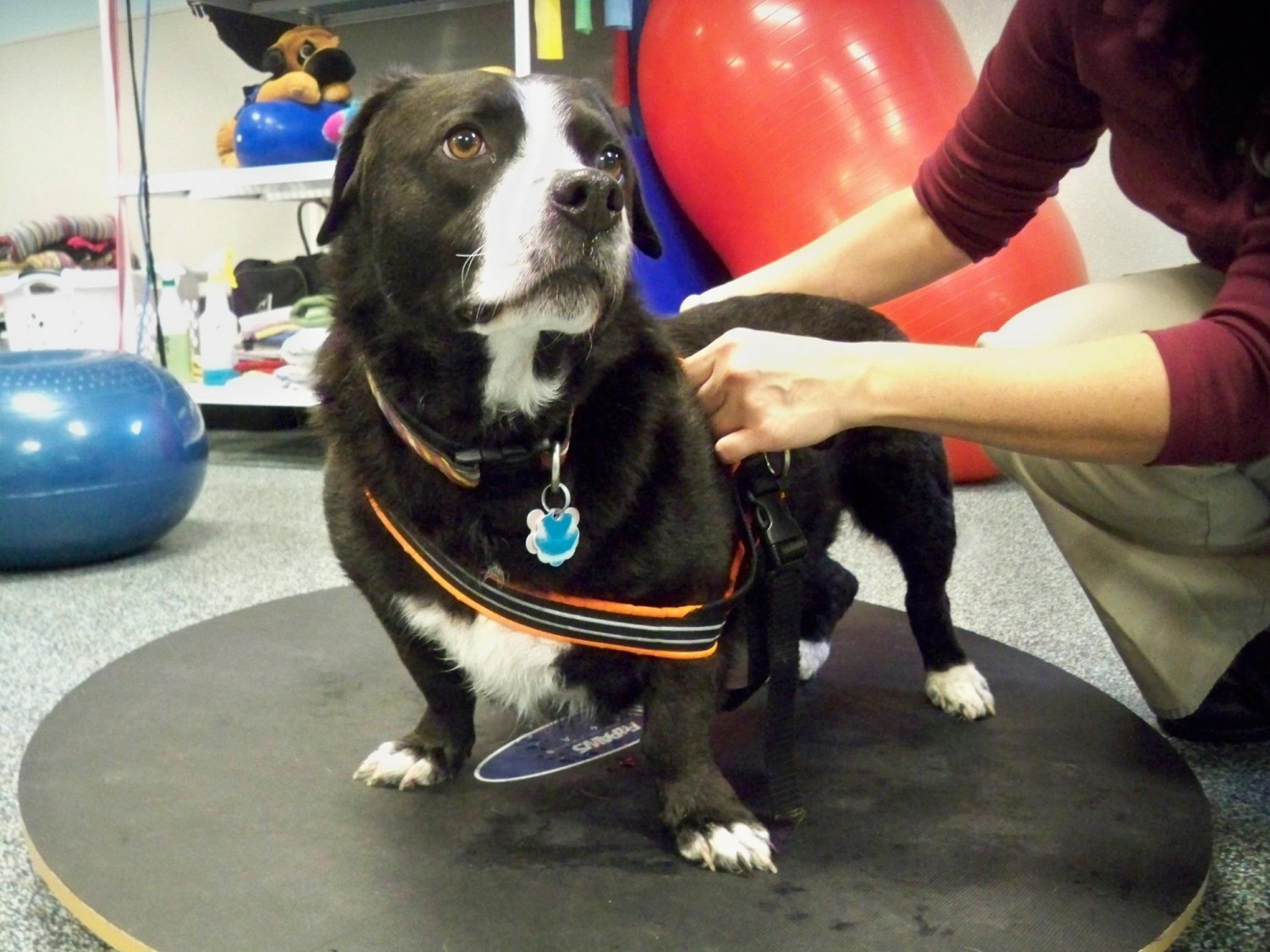Inter Vertebral Disk Disease (IVDD)
There are some dog breeds that seem to be more predisposed to back issues that others. You have the Daschund (poster child for IVDD, right?), Basset Hounds, Corgi and any mix making a long backed/short legged dog. There are also Pugs and French Bulldogs to round out the smaller dog list with Dobermans and German Shepherds having a solid representation for the large breed dogs. Some of their spine issues stem from congenital or developmental defects, but primarily in the veterinary hospital we see dogs with type I or type II disk compression.
When a disk (the shock absorber between vertebrae) changes to put pressure on the spinal chord, we usually see pain and loss of function in our pets. It can happen gradually over a few days to months or all of a sudden. The pain can be excruciating and dogs can become completely paralyzed and lose control of body functions. When this issue presents itself, it is important to seek out medical intervention as soon as possible for the best outcome.
My Dog May Have IVDD. Now What?
What are my options if I have a dog that suddenly looses the use of their legs or seems to be really stiff and can’t turn their neck? At the very least, an exam by a veterinarian would be a great place to start to localize where they think a disk lesion may be and to rule out other possibilities such as tick diseases.
The next step could be a visit to a neurology specialist to evaluate the symptoms and recommend a treatment plan that may include an MRI +/- surgery. Sometimes this option is not the best one due to the cost of the procedures or a patient’s age. If this is the case, does that mean that an owner should consider euthanasia as a treatment option? That really depends on the pain factor. If we can not effectively manage a dog’s pain and surgery is not an option, euthanasia may be the only way to humanely treat the issue. In particular, cervical lesions can be one of the most painful and difficult IVDD places to manage without surgery in some pets.
I strongly feel that if a pet’s pain can be controlled and the owners are committed to the intense home care needs of their dog, trying the conservative management strategy is definitely worth it. Time and good care can lead to partial or full recovery in some dogs. You just have to be willing to try with an unknown outcome possible. Recovery is not guaranteed but it is possible.
General Conservative Management Protocol for IVDD at our Hospital
- Pain Control
- Steroids
- Rest and Exercise Restriction
- Laser Therapy +/- Acupuncture
- Rehab Exercises (aqua therapy, strengthening exercises, etc…)
- *Most importantly: Time (time to recover, time to strengthen, time to figure it all out)*
Pain Control
Good pain control is essential for any patient dealing with a back issue. Get the pain under control with NSAIDs, opioids, muscle relaxers and/or any combination of the above to get on top of the pain so that we can then focus on the function (or loss of). Therapeutic laser can be an awesome tool to help with pain control. Many dogs dealing with IVDD have both sharp, shooting neurological pain as well as the pain that goes with tight, guarded muscles along the spine. Don’t forget about the use of heat for sore muscles. A warm compress over tight muscles or a stiff spine can reduce pain allow a pet to relax and get comfortable again.
Steroids?
There are two sides to the choice of medication in the medical management strategy- to use steroids or NSAIDs to manage spinal chord inflammation. Studies have shown that there is not a significant change in outcome with the use of steroids, but at our hospital we do use them in our back dogs. We have consistently seen better results using steroids in our patients over NSAID’s in general. Our basic conservative medical management protocol uses a tapering dose of prednisone, fentanyl patches, and different combinations of methocarbamol (muscle relaxer) +/- tramadol or gabapentin.
 Home Care of the Down Dog Home Care of the Down Dog
Rest and a change in environment is key to home care when managing a disk dog. Crate rest or confinement to a small area with opportunities for eliminations and minimum controlled therapeutic exercise is ideal for the first 4-6 weeks after being diagnosed with IVDD. Some dogs managing disk disease are ambulatory but weak or unsteady on their feet. Other dogs have lost the ability to walk all together and may be able to hardly stand. For the completely down dogs, I love the use of an x-pen or child’s playpen. They are a little bigger than a crate and can be moved room to room so that a recovering pet can be restricted but still be a part of family time. For the dogs that can walk but are unsteady, consider the use of baby gates to restrict space to one room at a time. Remove slippery surfaces by adding rubber backed throw rugs for dogs to walk on, block off stairs to avoid falls, block furniture if needed to avoid jumping on or off.
Many of these dogs are also dealing with loss of urine or fecal control. It is important for care givers to keep the pet clean and to quickly treat any sores that may develop. Initially, it may seem as if you are caring for an infant all over again with the poop and pee patrol as well as close monitoring of activity to avoid re-injury. Smaller dogs are, of course, easier to manage at home because we can pick them up and clean them in a sink or tub if necessary. Larger dogs can be a challenge and may require a “team” approach to home care for body needs and general management. The larger dogs also require more home help aids such as the “help-em-up” harness or belly slings to make assisted mobility easier on care givers. A little intense care in the beginning can give way to more independence as symptoms (hopefully) lessen and mobility returns. Take a deep breath, be patient, and give yourself and your dog some time to recover.
Laser and Acupuncture to the Rescue
We will begin laser therapy on the initial veterinary visit. Through the healing power of laser, we have found that we can help our patients relax their muscles, reduce the  arching of a painful spine, and be more open to other forms of rehab therapy. Ideally, laser should begin at three times weekly and the patient should be assessed at each visit. It is important to make sure that the laser treatment covers the suspected disk area as well as any supporting muscles above and below the lesion. Watch for secondary painful areas on other regions as the dog becomes more mobile and stresses other areas of the body. Once a positive result is seen, we begin to reduce laser sessions to twice weekly, then once weekly and so on and watch for any signs of regression. arching of a painful spine, and be more open to other forms of rehab therapy. Ideally, laser should begin at three times weekly and the patient should be assessed at each visit. It is important to make sure that the laser treatment covers the suspected disk area as well as any supporting muscles above and below the lesion. Watch for secondary painful areas on other regions as the dog becomes more mobile and stresses other areas of the body. Once a positive result is seen, we begin to reduce laser sessions to twice weekly, then once weekly and so on and watch for any signs of regression.
Acupuncture is also a great modality that can be started on the initial visit or even down the road if other treatments are not getting the desired results. Acupuncture with electro-stimulation can help to wake up the neuromuscular connections, reduce inflammation, and provide pain control. Usually sessions are once weekly for as long as we are seeing positive results. Acupuncture sessions can then be stretched out to every two to four weeks if function has returned or can be even be discontinued altogether.
Most of our patients suffering from IVDD get either laser or acupuncture but more commonly they get both modalities. It is important to remember that it is almost always a combination of therapies that work together to bring about recovery from a disk injury. The key is to follow up regularly with your veterinarian or rehab professional so that you can find the right combination that suits your pet’s current needs. Things can change on a weekly basis: rest and pain control today, laser and rehab exercises next week and so on.
 Rehab Therapy Is Important! Rehab Therapy Is Important!
As time goes on and the initial inflammation from the IVDD is managed, controlled activity and rehab therapy become the focus for strengthening and relearning basic functions such as standing and walking. Common exercise plans start with simple range of motion of all four limbs and progress to standing independently then move to encouraging the pet to take a few steps. Formal rehab therapy can be a powerful tool in a pet’s recovery. A therapist can demonstrate the basic exercises and things that you can do at home and then compliment that with aqua therapy or other modalities. We want to build up core strength, increase body awareness, and encourage good movement all with the goal of getting the patient back to as much independence as possible. All activity when the pet is walking during the recovery phase on their own should be done on a leash. Control of the situation is vital to avoid re-injury and distractions such as the dreaded bunny or squirrel. If given an option, our dogs will always choose the fun choice and that one is usually the worst choice for healing.
Anything is Possible with Time
In summary, our hospital believes in giving our patients a chance to heal and recover with or without specialty services such as an MRI or surgery. Conservative management is not the most ideal option in all cases, but it is definitely one to consider. Once pain is controlled and out of the picture, there are a variety of treatment options and potential outcomes for the dog faced with IVDD. We have seen smaller dogs begin therapy without motor and deep pain (a very big factor for a poor outcome) recover over time (weeks to months) to eventually walk on their own. Larger dogs are a bit of a bigger challenge and require more owner “muscle power” to manage. If an owner is willing to be a care giver and be committed to the rechecks and home care, then by all means try. Keep your expectations real and celebrate the return of each and any function (even if it is not exactly the same as before). Anything is possible and hope is a powerful tool in the healing journey.
|